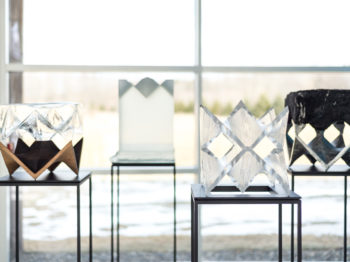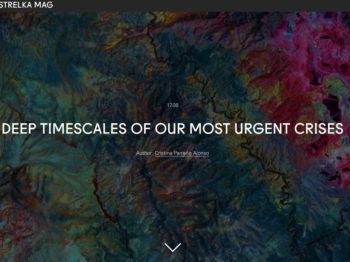
Cristina Parreño Alonso’s Tectonics of Wisdom
2020-21 Fay Chandler Creativity Grant
Expanding architecture’s temporal sensibilities through the material ancient wisdom of the library
About the Project
Tectonics of Wisdom: The Library, The Book, and Deep Time Material Events
Tectonics of Wisdom is an art installation that aims to expand architecture’s temporal sensibilities by examining the physical and material space of the library building.
In response to the question of the future of public architecture raised in an exhibition organized by the Schusev Museum of Architecture in Moscow, Tectonics of Wisdom situates the building of the library within the temporal scales of the Earth.
Tectonics of Wisdom is a project developed within the larger frame of Transtectonics, an ongoing research project by Cristina Parreño that examines cultural, contextual, and environmental implications of architectural material practice in the age of the Anthropocene. In the context of urgent global challenges occurring at planetary scales of time and space, Tectonics of Wisdom turns to a central network of human and material knowledge, examining the library through the lens of Transtectonics.
Tectonics of Wisdom is a growing archive of historical libraries described through “geological material events.” Each of these buildings (material as space) and their books (material as knowledge) is examined as a finite moment of convergence of matter and energy in flux–matter and energy which, crossing vastly different timescales, coincide in a specific place at a specific time in the form of a library. The Tectonics of Wisdom research project traces geological and human timelines that collapsed in extraordinary “material events” which defined the fate of these libraries and the human civilizations influenced by them.
The Library of Papyri. This Roman library housed more than 1,800 papyrus texts on philosophy and natural history. In 79AD, the town of Herculaneum was buried under layers of molten rock after the volcanic eruption of Mount Vesuvius, a devastating material event that destroyed the Library of Papyri while simultaneously preserving the papyrus scrolls, keeping them hidden under ash and lava until discovered eighteen centuries later.
The Royal Library of Ashurbanipal. The last king of the Neo-Assyrian Empire, Ashurbanipal was a warrior and intellectual who collected thousands of clay tablets in Akkadian cuneiform, including the original inscription of the Epic of Gilgamesh. At the Fall of Nineveh in 612 BC, his royal palace was set ablaze. The material event of the fires which destroyed the Royal Library of Ashurbanipal incidentally baked the clay tablets, preserving them for millennia.
The House of Wisdom. Fourteen centuries forward into the same geological timeline of the Tigris river, The House of Wisdom—the largest global repository of books in the mid-ninth century—stood at the capital of the Islamic Empire as a paragon of financial, spiritual, political, and intellectual wealth. According to legend, when the Mongols sacked Baghdad in 1258, so many books were tossed into the Tigris River that its waters ran black with ink for weeks.
Haeinsa Temple Library. Located within a Buddhist monastery, this library is home to the Tripitaka Koreana, the collection of 81,350 wooden printing blocks carved with Buddhist scriptures from the 13th century. A sophisticated preparation process required that the wood soak in sea water for three years, boil in salt water, and dry in the wind for another three years. Finally, the wood blocks were carved and preserved with a poisonous lacquer.
The Cave Library. Carved into a cliffside in China’s Gobi Desert, the Mogao Caves consist of a network of intricately carved Buddhist sanctuaries and temples. In 1900, monk Wang Yuanlu discovered a crack in one of the cave walls, revealing a hidden chamber filled to the brim with ancient texts. Sealed for 900 years, this library preserved more than 50,000 manuscripts, including the world’s oldest dated printed book.
Tectonics of Wisdom was also funded in part by a grant from the Council for the Arts at MIT.
Schedule
Upcoming Events
Carbon to Rock
May 22 – November 21, 2021
Biennale Architettura 2021 (Venice Architecture Biennale 2021)
How do we live together? As Emerging Communities – Exterior Interventions
Arsenale
Venice, Italy
Time Space Existence
May 22 – November 21, 2021
Palazzo Bembo, Palazzo Mora, and Giardini Marinaressa
Venice, Italy
A collateral event of the 2021 Architecture Biennale, hosted by the European Cultural Centre.
Past Events
Public Architecture – Future for Europe
January 31 – August 23, 2020
Schusev State Museum of Architecture
Moscow, Russia
Collaborators
Collaborators across multiple timelines of Tectonics of Wisdom:
Completed phase of the project:
Melika Konjicanin, G
Alyssa Li, ’20
Jackie Lin, ’20
Vanessa Pipitone, ’21
Future phase of the project:
Patricia Duenas, G
Ana McIntosh, G
Natalie Pearl, G
Carolyn Tam, G
Isabel Waitz, ’23
Biography
Cristina Parreño Alonso is a Spanish architect and designer based in Boston. She is also an educator at MIT, where her research project Transtectonics explores the cultural, contextual, and environmental implications of expanded temporal sensibilities in architectural material practice. Her “tectonic translations”—material transfers across spatial and temporal scales, beyond human and nature, technology, and geology—embody narratives that are told in the form of art exhibitions and through architectural installations that activate public spaces.
Cristina Parreño Architecture, her firm, was honored with the Europe 40 Under 40 Award in 2014 and the emerging firms award for the 2015 Design Biennial Boston. Parreño’s work has been published in the Journal of Architectural Education (JAE), ACADIA, Quaderns, and The Architect’s Newspaper. Parreño has taught at the State University of New York at Buffalo, Harvard Graduate School of Design, and MIT School of Architecture and Planning, where she currently teaches graduate and undergraduate design studios.
Other work by the artist:
Strelka Mag, Deep Timescales of Our Most Urgent Crises
MIT 4.154 Design Studio Igneous Tectonics: Carbon to Rock
Transtectonics Exhibition at MIT Keller Gallery
InConstruction Exhibition at ArtOmi
Biography: MIT Architecture
Website: cristinaparreno.com




